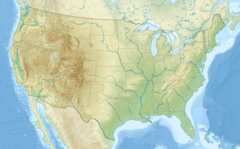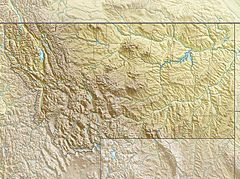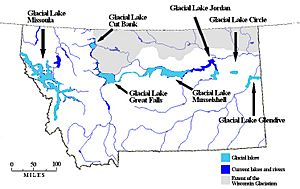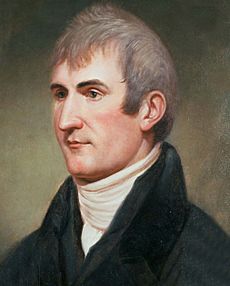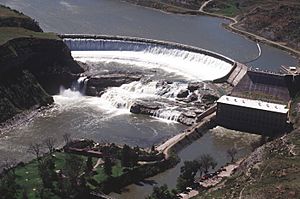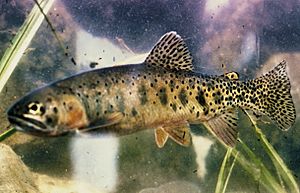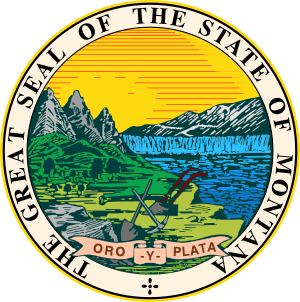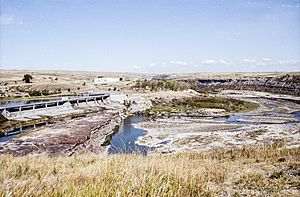Great Falls (Missouri River) facts for kids
Quick facts for kids Great Falls of the Missouri River |
|
|---|---|
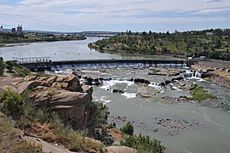
Black Eagle Falls and Dam in 2014
|
|
| Lua error in Module:Infobox_mapframe at line 185: attempt to index field 'wikibase' (a nil value). | |
| Location | Cascade County, Montana, U.S. |
| Coordinates | 47°34′12″N 111°07′23″W / 47.57000°N 111.12306°W |
| Total height | 187 feet (57 m) |
| Number of drops | 5 |
| Longest drop | 87 feet (27 m) |
| Watercourse | Missouri River |
| Average flow rate |
7,539 cu ft/s (213.5 m3/s) |
The Great Falls of the Missouri River are a group of five waterfalls. They are located on the upper Missouri River in north-central Montana, United States. These falls stretch over a 10-mile (16 km) part of the river.
The five falls, from upstream to downstream, are:
- Black Eagle Falls (26 feet 5 inches or 8.05 meters)
- Colter Falls (6 feet 7 inches or 2.01 meters)
- Rainbow Falls (44 feet 6 inches or 13.56 meters)
- Crooked Falls, also called Horseshoe Falls (19 feet or 5.79 m)
- Big Falls, also known as the Great Falls (87 feet or 26.52 m)
The Missouri River drops a total of 612 feet (187 m) from the first fall to the last. This includes 187 feet (57 m) of straight drops. It also includes 425 feet (130 m) of riverbed slope. People have called the Great Falls "spectacular" and "one of America's scenic wonders."
In 1805, the Lewis and Clark Expedition were the first white people to see the falls. Meriwether Lewis said they were the grandest sight he had seen on the journey. The Great Falls were later shown on the seal of the Montana Territory. They also appeared on the state seal of Montana in 1893.
Contents
Names of the Waterfalls
The Mandan Indians knew about these waterfalls. They called them Minni-Soze-Tanka-Kun-Ya, meaning "the great falls." The South Piegan Blackfeet had a special name for Rainbow Falls. They called it "Napa's Snarling." We do not know if Native Americans had names for the other four waterfalls.
American explorers Meriwether Lewis and William Clark named four of the five waterfalls in 1805. Both Lewis and Clark wrote about Crooked Falls in their journals. Clark named three other waterfalls on his map. He called them "Great Falls" (which is still its name), "Beautiful Cascade" (now Rainbow Falls), and "Upper Pitch" (now Black Eagle Falls).
"Beautiful Cascade" was renamed "Rainbow Falls" in 1872. This was done by Thomas B. Rogers, an engineer. He worked for the Great Northern Railway. Colter Falls was named by Paris Gibson to honor John Colter. Colter was a member of the Lewis and Clark Expedition. Black Eagle Falls is named after a black eagle. The eagle built a nest in a cottonwood tree on an island in the middle of the falls. The falls were called "Upper Pitch" before 1877.
How the Falls Formed
The Missouri River flows over a special area called the Great Falls Tectonic Zone. This is where two very old rock sections of North America meet. About 1.5 million years ago, the Missouri River and other rivers flowed north. They ended in a lake.
During the last ice age, huge ice sheets pushed these rivers south. Around 15,000 to 11,000 years ago, one ice sheet blocked the Missouri River. This created a giant lake called Glacial Lake Great Falls. About 13,000 years ago, the glacier melted. Glacial Lake Great Falls then emptied very quickly in a huge flood.
The Missouri River's path today follows the southern edge of that ice sheet. The rivers flowed east around the ice. They eventually settled into their current paths. As the ice melted, water rushed through the Highwood Mountains. It carved out the 500-foot-deep (150 m) Shonkin Sag. This is one of the most famous ancient meltwater channels in the world.
The Great Falls themselves formed where the river flows over different types of rock. The Missouri River settled into a rocky canyon. This canyon was under the clay left by Glacial Lake Great Falls. The river's path around the Great Falls has not changed much since then.
The Great Falls formed because the Missouri River flows over the Kootenai Formation. This rock layer is mostly sandstone from ancient rivers, glaciers, and lakes. Some of it is from shallow seas. The river wears away the softer sandstone. The harder rock forms the waterfalls. The Missouri River used to be much wider here. Now it flows in its current path, cutting deeper into the sandstone.
Discovery of the Falls
Early People
The first people to see the Great Falls were Paleo-Indians. They came to the area between 9,500 and 8,270 BCE. These early people entered Montana east of the Continental Divide. This was between two large ice sheets.
The area was not heavily populated for a long time. Salish Indians often hunted bison here in certain seasons. But there were no permanent homes near the Great Falls. Around 1600, Piegan Blackfoot Indians moved west into the area. They pushed the Salish back into the Rocky Mountains. The Blackfeet then claimed the area. The Great Falls remained in Blackfeet territory until Americans claimed the region in 1803.
We do not know when Native Americans first discovered the Great Falls. But the South Piegan Blackfeet knew the falls well by the late 1700s. News of the waterfalls had spread to native peoples as far east as central North Dakota.
Lewis and Clark Expedition
The United States bought the area around the Great Falls in 1803. This was part of the Louisiana Purchase from France. President Thomas Jefferson wanted to send an expedition to explore this new land. He got permission and money from Congress in January 1803.
On May 14, 1804, the Lewis and Clark Expedition left St. Louis, Missouri. Their goals were to map the Missouri River. They also wanted to see if a river route to the Pacific Ocean existed. They studied the Indian tribes, plants, geology, land, and wildlife. They also checked if British and French trappers were a threat to American control.
Expedition leaders Meriwether Lewis and William Clark first heard about the "great falls" from the Mandan Indians. This was during their winter stay at Fort Mandan from November 1804 to April 1805.
The Lewis and Clark Expedition reached the Great Falls on June 13, 1805. Meriwether Lewis was the first white person to see them. Lewis wrote about it in his diary:
- "...my ears were greeted by the sound of falling water. I saw spray rising like smoke. It would disappear quickly, probably due to the wind. I knew this roaring sound could only be the great falls of the Missouri. ... I hurried down the 200-foot-high hill to see this grand sight. ... The river is about 300 yards wide. About 90 to 100 yards of it is a smooth sheet of water falling over a cliff of at least eighty feet. The other 200 yards on my right is the grandest sight I have ever seen. The fall is the same height. But the uneven rocks below break the water into a perfect white foam. It takes a thousand forms in a moment. Sometimes it shoots up in sparkling jets fifteen or twenty feet high. Then large rolling bodies of foamy water cover them. The rocks seem perfectly placed to create a sheet of white foam 200 yards long and about 80 feet high. The water then hits the rock in front of me. It seems to bounce back and meet the strong current. They roll and swell into tall waves that rise and disappear instantly. This rock protects a nice little bottom land of about three acres. It has cottonwood trees that provide shade. At the end of this land, there is a thick grove of small cottonwood trees. In this wood, there are several Indian lodges made of sticks. ... The sun's reflection on the spray creates a beautiful rainbow. This adds to the beauty of this majestic scene. After writing this poor description, I looked at the falls again. I was so unhappy with how little it showed of the scene. I wanted to cross it out and start over. But then I thought I might not do better than writing my first thoughts. I wished for an artist's brush or a writer's pen. Then I could give the world a true idea of this magnificent object. It has been hidden from civilized man since the beginning of time. But this was useless. I truly regretted not bringing a camera obscura. With it, I could have done better. But that was also out of my reach. So, with only my pen, I tried to describe the strongest features of this scene. With this and my memory, helped by a good artist, I hope to give the world a small idea of this object. It fills me with such pleasure and wonder right now. I believe it is second to only one other thing in the known world."
The falls Lewis saw were the lowest of the five, the Great Falls. The next day, Lewis found Crooked Falls, Rainbow Falls, Colter Falls, and Black Eagle Falls. At Black Eagle Falls, Lewis saw something amazing:
- "I reached another waterfall of 26 feet. ... A little distance below this fall, a beautiful small island is in the middle of the river. It has many trees. On a cottonwood tree on this island, an eagle has built her nest. I believe she could not have found a more unreachable spot. Neither people nor animals can cross the deep gaps that separate her island from the shores. The water also breaks apart as it falls. The mist or spray rises very high. This waterfall is certainly the greatest I have ever seen, except for the two I mentioned below. It is much greater and a more noble sight than the famous falls of Potomac."
Lewis climbed a hill near Black Eagle Falls. He saw that the waterfalls ended there. Another large river joined the Missouri about two and a half miles upstream. It was late, but Lewis rushed to see this river. A grizzly bear attacked him. He ran over 80 yards and jumped into the Missouri River. Luckily, the bear did not follow. The Lewis and Clark Expedition had to portage (carry their boats and supplies) around the Great Falls. This was a very hard task that took almost a month.
York, an African American slave owned by William Clark, was part of the Expedition. He was the first black American to see the Great Falls.
The Lewis and Clark Expedition made many discoveries near the Great Falls. On June 13, Silas Goodrich caught many Westslope cutthroat trout at the falls. This was the first time anyone in the expedition had seen these fish. Several fish were saved as examples. The trout was later named Oncorhynchus clarki lewisi to honor the expedition leaders. The Westslope cutthroat is now the official state fish of Montana. The explorers also found the first samples of the gumbo evening primrose and the western meadowlark at the Great Falls.
On June 18, William Clark explored the south side of the Missouri River with five others. He discovered Giant Springs. He correctly thought it was the largest spring in the world. He was the first white person to see the springs. He was also the first white person to see the falls from the south side of the Missouri.
Meriwether Lewis visited the Great Falls again on July 11, 1806. This was when the Corps of Discovery returned east. Lewis and nine men stopped at the Great Falls. They planned to explore the Marias River. But during the night, Native Americans stole half of their 17 horses. This forced three men to stay behind.
Settling the Area
After Lewis and Clark returned in 1805-1806, no white person recorded visiting the Great Falls until 1822. That year, explorer and trapper Jim Bridger reached them. White people next visited the Great Falls in April 1823. Bridger and Major Andrew Henry led a fur-trading trip there. Blackfeet Indians attacked them while they camped. British explorer Alexander Ross trapped near the Great Falls in 1824. In 1838, a mapping trip from the U.S. government, guided by Bridger, spent four years in the area. Margaret Harkness Woodman was the first white woman to see the Great Falls in 1862.
The first lasting settlement near the Great Falls was Fort Benton. It was built in 1846, about 40 miles (64 km) downstream. The Great Falls marked the end of the part of the Missouri River that boats could travel. The first steamboat arrived at the falls in 1859. In 1860, the Mullan Road connected Fort Benton to Fort Walla Walla in the Washington Territory.
Over the 1800s, the Great Falls area changed hands many times. It was part of the wild frontier until May 30, 1854. Then, Congress created the Nebraska Territory. Attacks by Native Americans on white explorers and settlers went down a lot after 1855. This was when Isaac Stevens made the Treaty of Hellgate. White settlement then began in the area.
On March 2, 1861, it became part of the Dakota Territory. The Great Falls were then part of the Idaho Territory on March 4, 1863. Then they became part of the Montana Territory on May 28, 1864. It became part of the state of Montana on November 8, 1889.
The Great Falls of the Missouri River became the site of a permanent town in 1883. Businessman Paris Gibson visited the Great Falls in 1880. He was very impressed by the chance to build a big industrial city there. The city could use power from hydroelectricity. He returned in 1883 with surveyors. He planned a city (to be named Great Falls) on the south side of the river. The city's first citizen, Silas Beachley, arrived later that year.
With money from railroad owner James J. Hill and Helena businessman C. A. Broadwater, houses, a store, and a flour mill were built in 1884. A planing mill, lumber yard, bank, school, and newspaper were started in 1885. By 1887, the town had 1,200 people. In October of that year, the Great Northern Railway arrived. Great Falls, Montana, became an official city on November 28, 1888. Black Eagle Dam was built in 1890. By 1912, Rainbow Dam and Volta Dam (now Ryan Dam) were all working.
The city of Great Falls, Montana, gets its name from the waterfalls. The small town of Black Eagle, Montana, is named after Black Eagle Falls. Cascade County (where both are located) is named for the waterfalls and rapids.
Dams on the Falls
Only one of the Great Falls, Crooked Falls, still looks natural today. Dams built on the falls since the 1880s have changed them a lot. Some parts of the waterfalls are even underwater. Black Eagle Dam was built in 1890. Half of Black Eagle Falls are now covered by the water behind the dam. This was the first hydroelectric dam built in Montana.
Rainbow Falls was dammed in 1910 when Rainbow Dam was built. The water behind this dam covered Colter Falls.
Volta Dam was built on top of the Great Falls in 1915. It was later renamed Ryan Dam in 1940. This was to honor John D. Ryan. He was the president and founder of the Montana Power Company.
Places to Visit and Learn
The Great Falls Portage is a National Historic Landmark District. It was named in 1966. It marks the path Lewis and Clark used to go around the falls. The areas, including their camps, are located above and below the falls. The Great Falls are also part of the Lewis and Clark National Historic Trail. Congress created this trail in 1978.
The Lewis and Clark National Historic Trail Interpretive Center was built in 1998. It is on a cliff overlooking the Missouri River near Crooked Falls. It teaches about Lewis and Clark's discovery of the Great Falls. It also shows how they carried their boats around them. There are also exhibits about the native peoples of the area.
In 1989, the City of Great Falls and other groups created the River's Edge Trail. This is a 30-mile (48 km) series of paved and unpaved paths. They follow the Great Falls and the Lewis and Clark Expedition portage route. They also go through other scenic and historic areas of Great Falls and Black Eagle.
The Falls in Art
The first known drawing of the Great Falls was made by Meriwether Lewis in his diary. In 1807, Lewis asked an Irish artist, John James Barrelet, to draw the Great Falls. After Lewis died in 1810, William Clark found the drawings. But they have since been lost.
The Great Falls have been shown in famous paintings. You can see the waterfalls in the background of John Mix Stanley's painting "Barter for a Bride." This painting was made between 1854 and 1863. It is now in the U.S. State Department in Washington, D.C.. The famous Western painter O. C. Seltzer painted the waterfalls in his 1927 work. It is called "Lewis and Clark With Sacajawea at the Great Falls of the Missouri, 1804."
The first known photograph of the Great Falls was taken by James D. Hutton. He was a famous Western photographer. He took it around 1859 or 1860.


